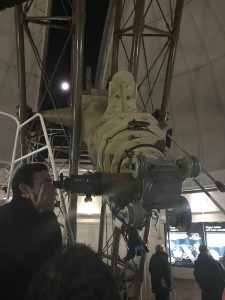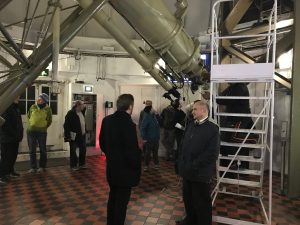October 31, 2017
Viewing with the Great Equatorial Telescope – Tuesday 31st October
Report by: Tej Dyal
 A few minutes before the Flamsteed’s first session with the Great Equatorial Telescope began, members were sat in the cafeteria guessing what our backup program might entail, for all we saw outside were clouds everywhere we looked. But then ROG’s astronomer, Brendan Owens, approached us with his usual beaming grin of optimism and told us to follow him to the telescope dome for a session of observing a waxing gibbous moon. So with that surge of anticipation, members were led to the dome…though we couldn’t help noticing that the skies were still entirely covered with clouds!
A few minutes before the Flamsteed’s first session with the Great Equatorial Telescope began, members were sat in the cafeteria guessing what our backup program might entail, for all we saw outside were clouds everywhere we looked. But then ROG’s astronomer, Brendan Owens, approached us with his usual beaming grin of optimism and told us to follow him to the telescope dome for a session of observing a waxing gibbous moon. So with that surge of anticipation, members were led to the dome…though we couldn’t help noticing that the skies were still entirely covered with clouds!
Turns out, the clouds were thin enough for the very large light gathering telescope (28-inches aperture) to penetrate through, allowing Brendan to heroically defy the persistent cloud cover (plus the Moon’s low altitude) and show us some of the Moon’s interesting features while describing absorbing facts about them and of the vintage telescope itself.
For each target region we viewed, Brendan also fed through a live video image onto two monitors from a camera attached to the 6 inch refractor that is piggy backed to the main 28 inch refractor. This live feed serves as an excellent tool for Brendan to discuss the features while we take it in turns to view through the eyepiece. The actual views of the craters through the eyepiece were astounding in clarity, far more so than what was fed through to the monitors. We observed the following:
1. Gassendi crater. This was a large crater, 110km diameter, bordering on the smooth lava filled region called Mare Humorum. The lava from this region filled the crater and so we observed high peaks in the middle region which are basically the tips of mountains now buried beneath the lava. We observed some smaller craters within this crater known as craterlets.
2. Aristarchus crater. Brendan then slewed the telescope onto a contrasting binary crater system, one of which stood out considerably in its luminosity. This is called the Aristarchus crater (85km diameter) which he explained has the highest albedo on the moon (ie the most reflective), hence its brightness. Its a very deep crater, twice as deep as the Grand Canyon, and in this waxing gibbous moon phase, creates a startling polarising effect with one side glistening on valley rimmed sloping walls and the other side hidden in shadow. The albedo properties of this crater have puzzled and fascinated astronomers for centuries.
3. Herodotus crater. The partnering crater, next to Aristarchus, is a slightly smaller one called Herodotus (85km diameter) which in contrast to Aristarchus has a very low albedo and despite its large area, has a noticeably very thin rim and and much more shallow in depth.
 Due to the cloudy seeing conditions, we observed all the above craters at around a moderate 200x magnification but for Aristarchus and Herodotus system, Brendan cranked the magnification up to an astounding 425x mag. Whilst a little more fainter, we observed more details on these very contrasting craters (albeit, through an alarmingly dirty eyepiece! We’ll see to having a clearer high power eyepiece available in future GET events).
Due to the cloudy seeing conditions, we observed all the above craters at around a moderate 200x magnification but for Aristarchus and Herodotus system, Brendan cranked the magnification up to an astounding 425x mag. Whilst a little more fainter, we observed more details on these very contrasting craters (albeit, through an alarmingly dirty eyepiece! We’ll see to having a clearer high power eyepiece available in future GET events).
Brendan explained that all these craters lie near to what is referred to as the terminator, the line in which the lit part of the moon meets the unlit part. This is the best region for observing craters as they reveal more depth. Of course as the Moon phases change, so does the terminator. So, on each night of all the moon phases, different craters reveal their true depth.
As some members squeezed in 2nd helpings of the last target with some quick smartphone snaps at the eyepiece, Brendan wrapped up his engaging talk on the Moon and telescope. We thanked him profusely for his generous time and determination in giving us a guided tour of some of the Moon’s fascinating features.
If you would like to discuss/chat or ask questions about our events or anything about astronomy, or share your own astronomy related experience, please do come and ask/chat away on our members forum at http://www.flamsteed.org.uk/forums/
Pictures from the Event (by Mike Meynell):
Posted under: 28-Inch Equatorial Viewing, Flamsteed, Meeting Report, Stargazing



You must be logged in to post a comment.